No Products in the Cart
Chinmay Shankar, a dynamic writer and independent creative consultant in India, excels in copywriting, video production, advertising, and brand marketing. Read more
Last Updated September 6, 2024
If we can define weighted blankets in a few words, then those words would be "like a big hug." How do you feel when someone you like hugs you? That warm, fuzzy feeling is good enough to calm you down. A weighted blanket does the same but in a different manner. With all the benefits that come with using a weighted blanket, it's no wonder why so many people are turning to them these days.
But before making such an investment, it is important for buyers to understand what makes a good weighted blanket, and how it complements your mattress - which is exactly what this ultimate guide on weighed blankets hopes to address! Get ready to learn all about their uses, advantages, and differences in fabrics & weights as we dive into our ultimate guide to finding the perfect weighted blanket.
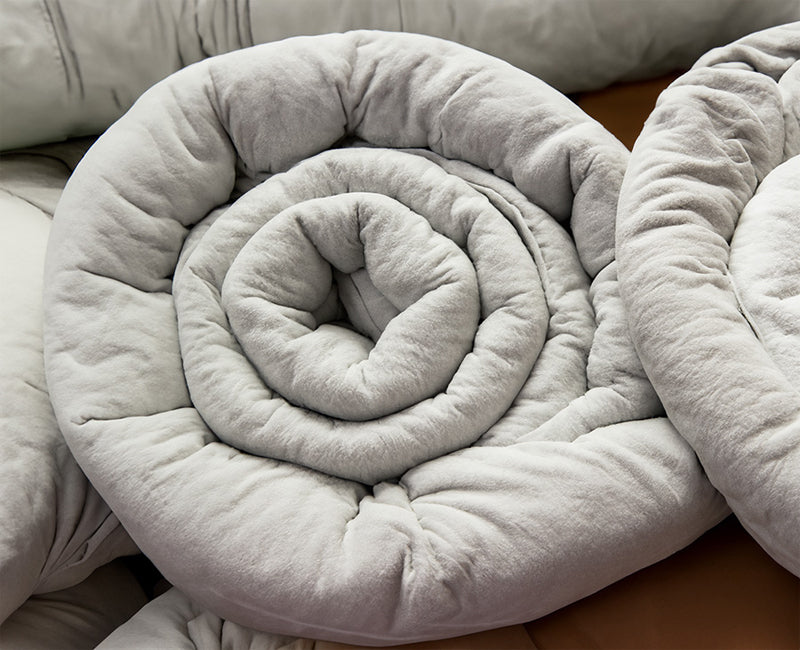
Key Takeaways:
Weighted blankets combine the power of deep pressure stimulation (DPS) with comforting materials to create a calming and soothing effect. This therapeutic technique has been found to aid in relaxation, reduce anxiety, and improve sleep quality for individuals with various conditions, such as autism, sensory disorders, and post-traumatic stress disorder.
The magic behind weighted blankets lies in their fillers, which add weight to the blanket and provide comforting pressure. The most common types of fillers include plastic pellets, glass beads, and steel shot. Each filler has its advantages and disadvantages, which we'll explore in the following sections.
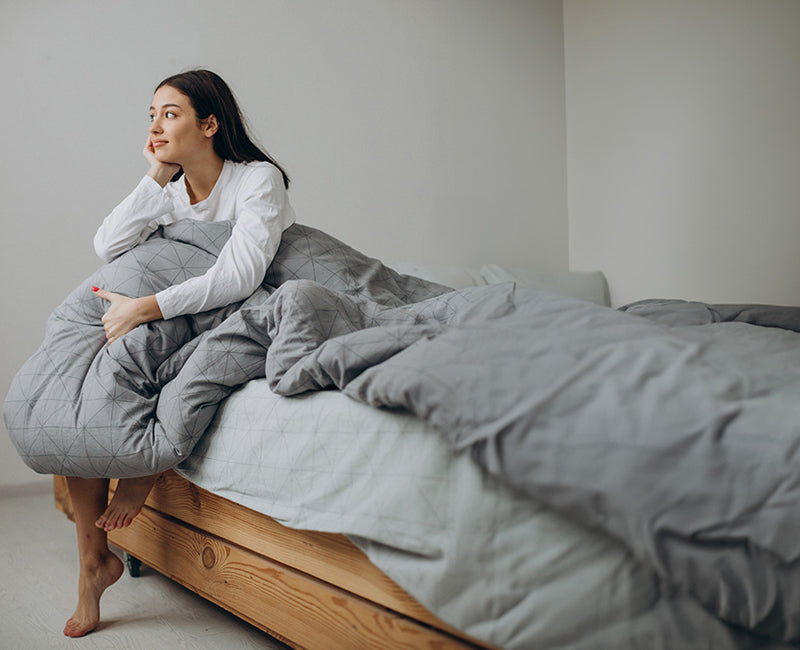
Weighted blankets are engineered to provide an added sense of comfort and warmth. Their design factors in your body weight and bed size to ensure that the blanket distributes pressure evenly. The gentle, consistent pressure can create a cocoon-like sensation, which many find comforting and conducive to relaxation.
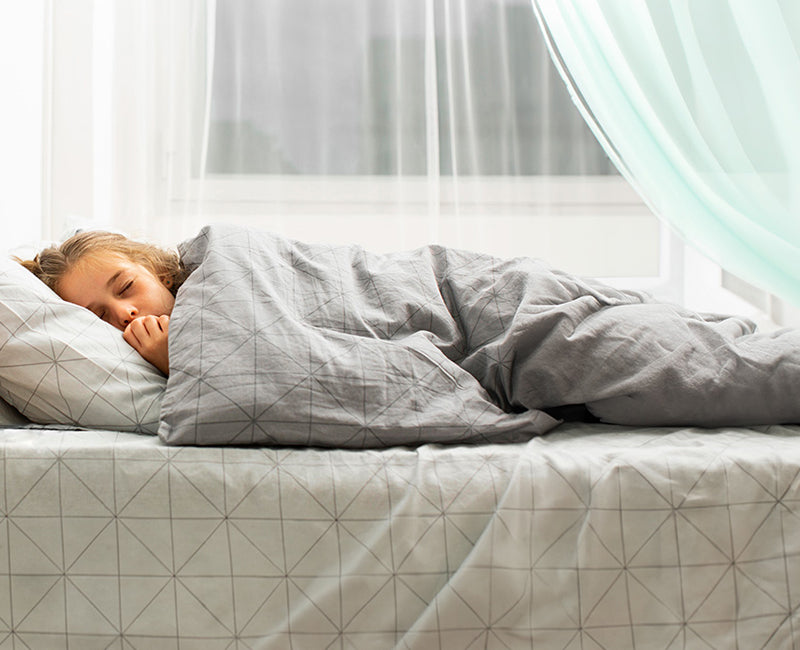
Weighted blankets utilize a well-researched therapeutic approach called Deep Touch Pressure (DTP). DTP involves applying pressure to certain areas of the body, such as nerves, skin, and joints. This pressure helps stimulate the release of serotonin, a neurotransmitter associated with feelings of well-being and happiness.
Weighted blankets are not just ordinary bedding items; they have gained recognition and recommendations from occupational therapists. The deep pressure they provide mimics the sensation of a warm hug, effectively soothing the nervous system. This can lead to a reduction in cortisol, the stress hormone, and an increase in serotonin and dopamine, the "happy hormones." The result is improved mood and emotional well-being, making them ideal for use during relaxation and sleep.
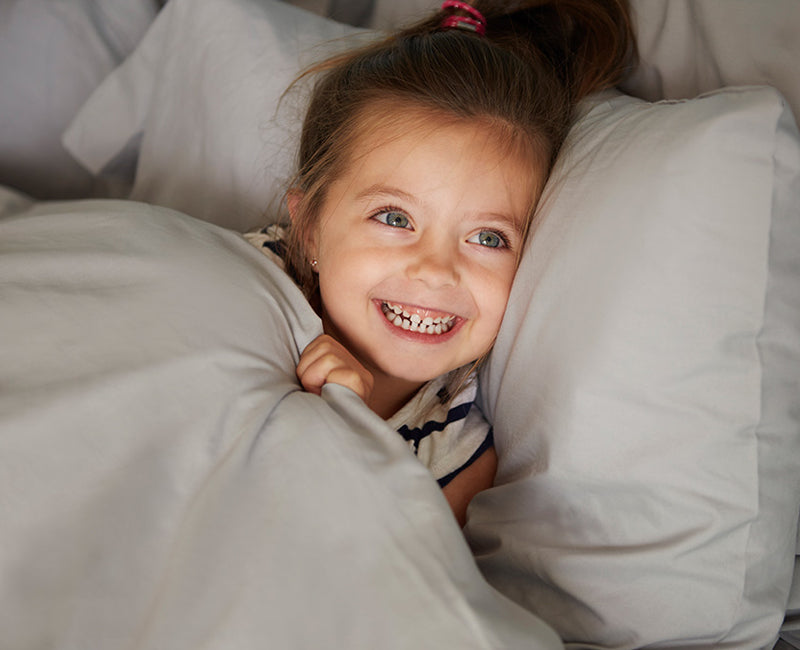
Weighted blankets have shown promise in helping individuals with various conditions. For children with ADHD or autism, weighted blankets can provide a sense of security and stability, helping them stay in bed and fall asleep quickly.
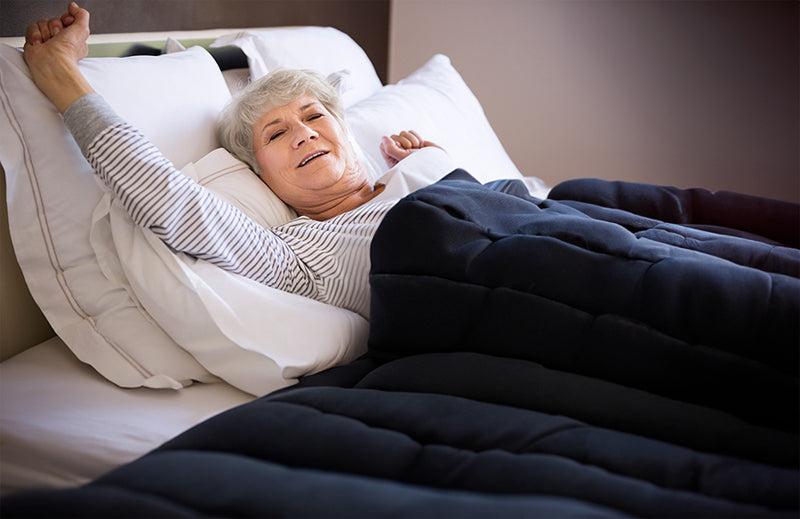
Osteoarthritis, a condition characterized by joint pain and stiffness, can be eased by using a weighted blanket. These blankets offer consistent, gentle pressure, providing the patient with the comfort of a soothing, supportive hug. This pressure helps reduce discomfort and joint pain associated with osteoarthritis.

Medical procedures often make people nervous, and using weighted blankets seems to help calm them down. A study in 2016 tried this with people getting their wisdom teeth removed and found that those who used weighted blankets felt less anxious. They did a similar study with teenagers having a molar extraction and got similar results.
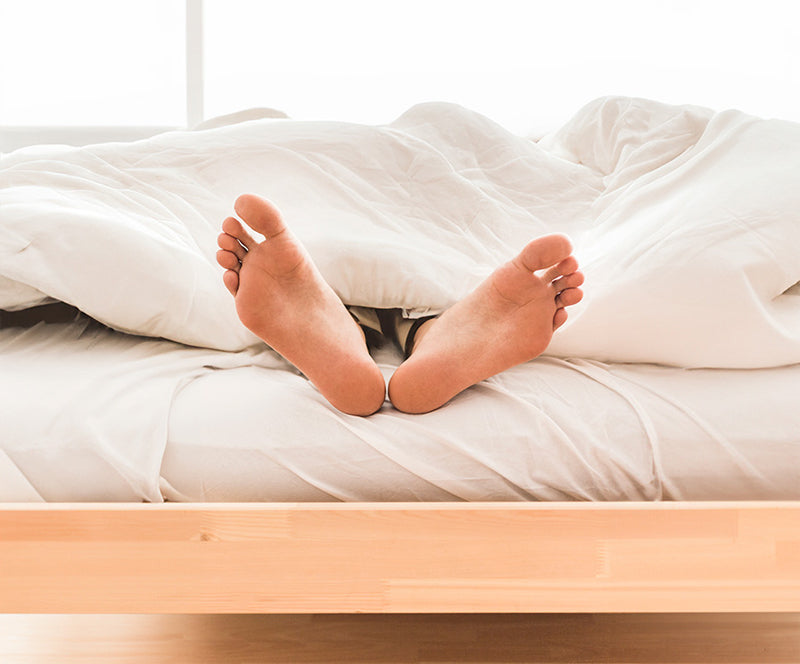
Restless Legs Syndrome is a condition characterized by uncomfortable sensations in the legs, leading to restless movements. Weighted blankets can be beneficial in multiple ways. The gentle pressure provided by the weighted blanket serves as a sensory distraction, potentially reducing the urge to move restless legs. It can provide comfort and aid in falling asleep more easily. Moreover, weighted blankets improve sleep quality, which is essential for individuals with RLS, as poor sleep can exacerbate their symptoms.
Individuals living with chronic pain can find relief and comfort with the use of weighted blankets. These blankets offer consistent, deep pressure touch that can alleviate the discomfort associated with chronic pain conditions. By easing muscle tension and reducing pain, weighted blankets contribute to pain management. They also help improve sleep, which is vital for individuals dealing with chronic pain, as restful sleep plays a significant role in effective pain management.

Individual experiences with weighted
blankets may differ, but some users have reported a reduction in the frequency of seizures as a potential
positive effect. This is attributed to the deep pressure stimulation offered by the blanket, which can have a
calming impact on the parasympathetic nervous system. This, in turn, can create an overall sense of well-being and
may help lower the incidence of seizures in certain cases.
Menopause often brings symptoms like hot flashes and night sweats, which can disrupt sleep and cause discomfort. Weighted blankets can help by providing a comforting, even pressure that regulates body temperature and promotes relaxation. This can lead to better sleep quality and reduced discomfort during menopause.
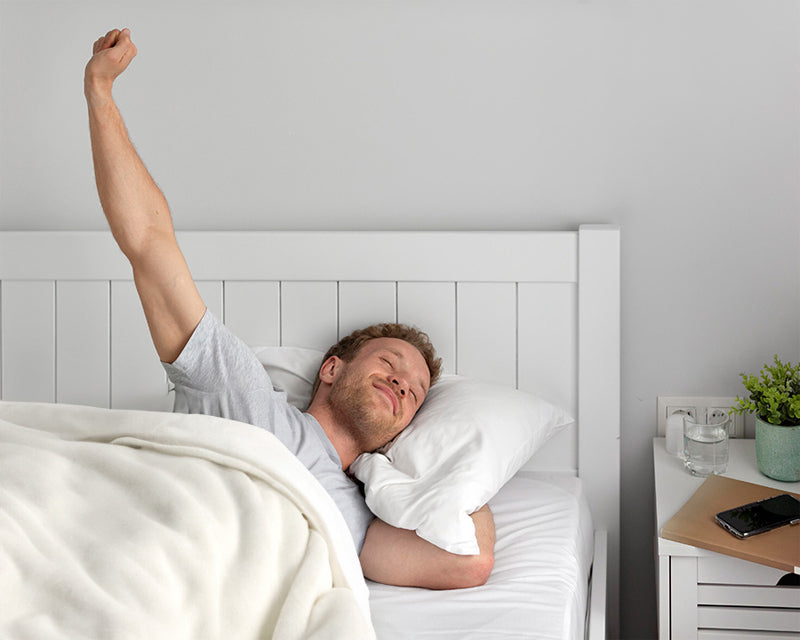
Weighted blankets can be part of managing OCD symptoms. The gentle, consistent pressure they provide creates a sense of security and can reduce anxiety. This can be particularly helpful in calming obsessive thoughts and reducing compulsive behaviors associated with OCD.
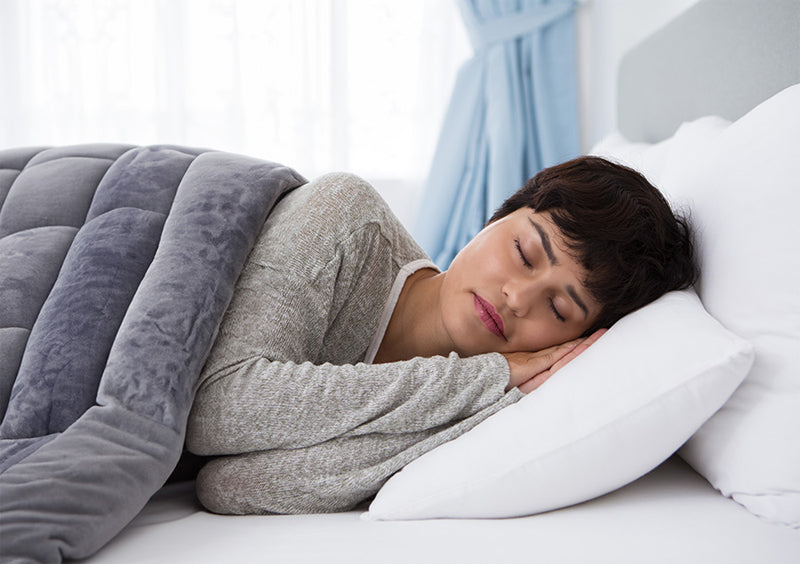
Weighted blankets can stimulate the production of serotonin, a neurotransmitter that contributes to feelings of well-being and relaxation. The deep touch pressure from the blanket may trigger the release of serotonin, leading to an improved mood and reduced stress.
Kids under three years of age should not be tucked in a weighted blanket. It can be too much for them. The pressure and the warmth from these blankets can make them gasp for air, so it is better to keep small kids, toddlers, and babies away from them.
People with sleep apnea or who are asthmatic should avoid sleeping under a weighted blanket. At times, they can feel claustrophobic as it increases body temperature. When buying a weighted blanket for such family members or friends, always ask first or seek advice from an experienced professional.
Most weighted blankets are heavier than your average heavy blanket. They are also bulky and made to fit your bed size. We know once you get used to it, you will miss it during your holidays, but it is difficult to carry around. Also, Airline companies won't allow it due to the extra weight it brings in.
While weighted blankets are definitely warm and cozy, it might take you a good amount of time to get used to their feel. They are different from traditional blankets. Hot sleepers might find it better to get a blanket independently that does not have such heavy fillings in it.
Due to the different sorts of fillings, sturdy stitching, and material used for the removal cover, most weighted blankets take a good amount of time during production. With the added weight and care instructions, transportation and maintenance costs rise. Add your personal preference to it, and you have already signed up for a luxury product. Not that it doesn't stand by the promises it makes on the packaging, but nonetheless, it is still expensive compared to other adult blankets.
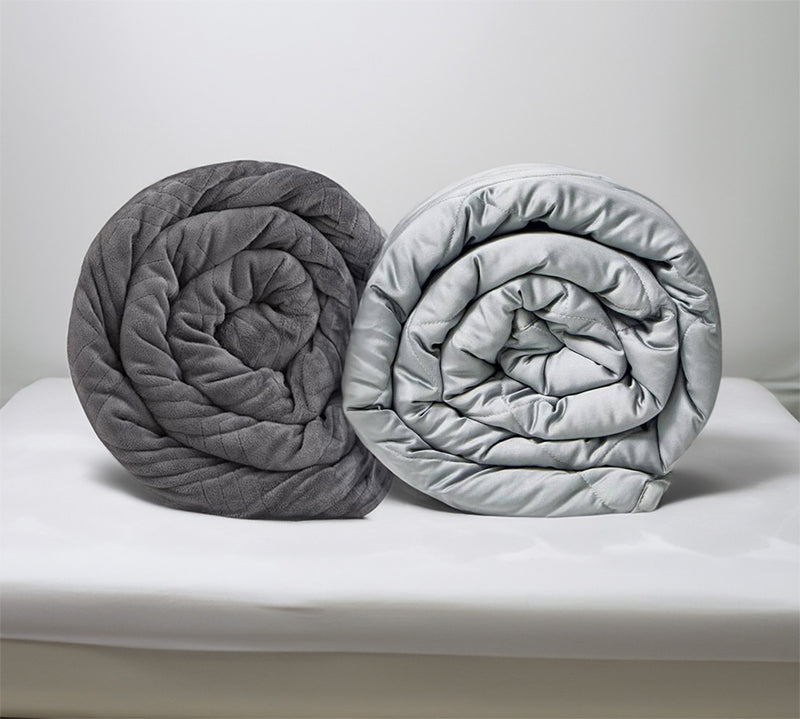
Selecting the perfect weighted blanket involves determining the ideal weight, size, and material to suit your needs. To help you make the right decision, we'll discuss each of these factors in detail and provide tips on how to choose the best weighted blanket for you.
The weight of a weighted blanket plays a crucial role in providing the desired level of deep-pressure stimulation. Most experts recommend choosing a blanket that is approximately 10% of your body weight. However, depending on your personal preference and comfort level, you may opt for a blanket that is 5 to 12 percent of your body weight.
A study found that using a standard-weight weighted blanket reduced anxiety in chemotherapy patients of various weights.
Keep in mind that any changes in your weight may affect the comfort of your weighted blanket, so it's essential to consider this factor when making your selection. If you're unsure about the best weight for you, it's always a good idea to consult with a healthcare professional or try out a few weighted blankets before making your final decision.
| BODY WEIGHT | BLANKET WEIGHT |
|---|---|
| 120 pounds | 12lb blanket |
| 130 pounds | 13lb blanket |
| 140 pounds | 14lb blanket |
| 150 pounds | 15lb blanket |
| 160 pounds | 16lb blanket |
| 170 pounds | 17lb blanket |
| 180 pounds | 18lb blanket |
| 190 pounds | 19lb blanket |
| 200 pounds | 20lb blanket |
| BODY WEIGHT | BLANKET WEIGHT |
|---|---|
| 20 pounds | 3-4 lbs blanket |
| 30 pounds | 4-5 lbs blanket |
| 40 pounds | 5-6 lbs blanket |
| 50 pounds | 6-7 lbs blanket |
| 60 pounds | 7-8 lbs blanket |
| 70 pounds | 8-9 lbs blanket |
| 80 pounds | 9-10 lbs blanket |
| 90 pounds | 10-11 lbs blanket |
| 100 pounds | 11-12 lbs blanket |
Weighted blankets come in various sizes, including twin, full, queen, and king. The size you choose should correspond to the dimensions of your bed or the space where you intend to use the blanket.
The size of a weighted blanket also affects its weight distribution, so it's essential to find one that provides even pressure across your body.
The material of your weighted blanket is another vital factor to consider, as it directly affects your comfort and sleep quality.
To make the most of your weighted blanket, it's essential to choose a material that provides the right level of comfort and temperature control for your needs. For example, if you tend to sleep hot, you may prefer a breathable fabric like bamboo-derived viscose or organic cotton. On the other hand, if you're looking for a cozy and warm option, minky polyester or fleece might be more suitable.
A weighted blanket is more than just another heavy blanket. It has to be heavy enough to restrict your unnecessary movements, and at the same time, it should be breathable. That means the fillings and covering material have to be right. Let's see how you can choose a weighted blanket based on what's inside it.
While the name might sound like an industrial one, this is the most common filling you might have seen around you. Manufacturers use these pellets, especially in stuffed toys, as they are level 5 plastic and are considered safe for children and young adults.
The best part about plastic poly pellets is that they are flexible, easy to shape, and can contour the body. This makes poly pellets the best material for filling a weighted blanket. If you have 100% virgin polypropylene in your plastic pellets, then your blanket is machine-washable and non-toxic.
The only problem you can face is the off-gassing from poly pellets, as they are petroleum-based industrial products, but the smell should dissipate with time. But people who have skin and noise sensitivity find the rustle and smell of polypropylene a bit off-putting. If you are willing to take the risk, plastic poly pellets can be an inexpensive filling for your weighted blanket.
You might have seen them in a craft and novelty store, but did you know that weighted blanket manufacturers also use these micro glass beads as fillings? Yes, they are relatively more expensive than plastic beads or polypropylene, but the best weighted blanket will have glass or steel beads as fillings. We will come to steel beads later, but now let's take a glance at why glass beads are considered the best choice for a weighted blanket.
Compared to traditional weighted blankets, the ones filled with glass beads are heavier. But they also make weighted blankets thinner and less bulky.
Since most weighted blankets have square pockets with fillings inside them and stitched on the outside, the structure makes the weight evenly distributed. Glass beads fit right in this category. Plus, the glass beads ensure that nothing happens to your weighted blanket during machine washing. They are also dryer-safe. Glass bead filling is safe for kids and young adults, too.
Compared to glass beads, steel shot beads are larger and heavier. It goes without saying that they are on the costlier side due to the higher manufacturing costs. But in the category of weighted beads, steel shot beads are the best, even if not very popular.
Smooth, round, and durable, these steel shot beads are the cleanest form of filling for your weighted blankets. They stay within their pockets and won't leak through stitches. A weighted blanket filled with steel shot beads is fully machine washable. If you are not going to wash the entire blanket at home, then you can remove the washable cover and get that machine washed.
The only issue steel shot beads filled blankets have is that, despite being high-quality blankets, they can be noisy. It can be distracting for kids with ADHD and adults who don't like the rustling noises. But apart from that, a weighted blanket with steel shot beads filling is still the safest bet compared to many weighted blankets on the market.
It seems like an odd choice here, but many manufacturers do use sand as filling in their weighted blankets. It can be dirt cheap (no pun intended), but at the same time, it has no toxicity, and the completely organic (semi-organic) material in your inner blanket feels really good on your skin.
But if you are going with the sand filling, make sure that you choose a good weighted blanket. If the top cover and square pockets of your weighted blanket are not sealed properly, then there is the possibility that sand might leak. Also, sand-filled blankets are not like other weighted blankets. Make sure that you have a machine washable cover, at least, because the moment you wash your sand-filled weighted blanket, it might lose its shape. Sand can become messier and harder at a place, forming lumps.
It's better you keep one near your pool rather than in your bedroom. So that even if it gets sandy, it will be part of the decor.
Don't worry; you are not lying down under some fancy gunny bags. Grains as a blanket filling have been an old custom in Asia and other continents. Uncooked rice (obviously), crop grains, buckwheat, etc.
While grain-filled weighted blankets might seem affordable, in the long run, they're anything but. Expensive weighted blankets are known for their stitching, fillings, and overall quality. When you compromise with fillings, like in this case, with grains - you see the impact once the same blanket has to stand the test of time and weather.
Once the rainy season starts, grains in the so-called 'affordable weighted blanket’ start capturing moisture and developing mold and allergens. You wouldn't want that. Would you?

Another experimental option is a filling in which a weighted blanket has to take the blame for being uncomfortable. Remember, the filling in your weighted blanket is as important as its machine-washable cover or breathable fabric.
Pebbles, while accessible and affordable, can be uneven and tear the stitches. Once they get moist, they can be the reason for developing mold and mildew in blanket cloth, too.
It is better that you choose wisely. No matter what other weighted blanket manufacturers are experimenting with, you only go with the trusted one. The one that has the best overall weighted blanket, based on the criteria of fabric, stitching, fillings, and quality.
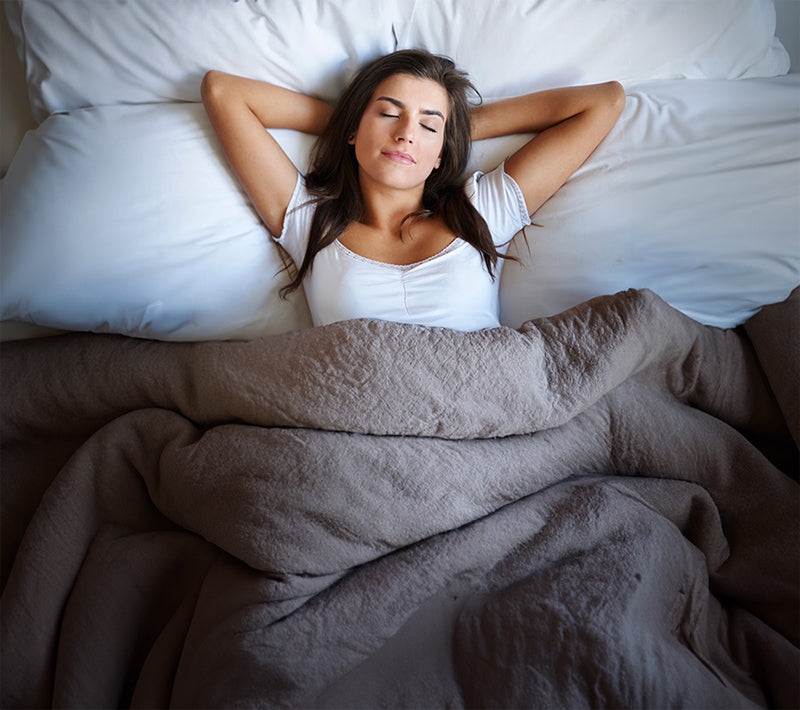
Your body parts are at ease when you sleep on your back. With a weighted blanket, your sleeping position becomes more crucial. You can also sleep on your sides, but that won't provide the much-needed deep-pressure therapy.
And be careful if you are sleeping on your stomach under a weighted blanket; you might wake up with pain in your lower back if you do not take the weight and fillings of your blanket into consideration. A stomach sleeper can choose a knit weighted blanket with plastic pellets as fillers so that the overall weight of the blanket stays on the lighter side. If you are a stomach sleeper and don't like the bumpy texture of a knit-weighted blanket, you can choose a cotton-weighted blanket, too.
But remember, whether you call it a pound blanket or a gravity blanket, the best-weighted blanket always takes care of all types of sleepers - whether back, side, or stomach. It all depends on how you choose what's right for your sleep and your body.
To maintain the quality and longevity of your weighted blanket, it's essential to care for it properly by following the appropriate washing, drying, and storage instructions.
In this section, we'll provide guidance on how to care for your weighted blanket to keep it looking and feeling its best. However, the care guidelines for your weighted blanket can vary depending on the materials used, such as cotton, polyester, rayon, and wool, and the type of fill, like glass beads, plastic pellets, or organic materials. Always refer to the tag, owner's manual, or the manufacturer's website for specific care instructions.
Assess the weight and filling: If your blanket is over 25 pounds or contains fillings like grains, beans, or sand, avoid machine washing. These heavy blankets are better suited for handwashing or spot cleaning.
Use the right detergent: For machine washing, use a mild detergent and avoid bleach or fabric softeners. Heavier blankets may still benefit from handwashing or spot cleaning to maintain their integrity.
Spot clean stains: For small stains, use mild soap and warm water or soak the affected area in a bathtub. Always opt for air drying after spot cleaning.
Deep cleaning: If you think your weighted blanket needs a deep clean, you can use a washing machine or wash it by hand in a bathtub or sink. Either way, make sure to use a mild detergent without bleach and wash it in cold or warm water, as hot water may damage the blanket.
Beware of steel beads: If your weighted blanket contains steel beads, they may damage your washing machine. Consider using a machine-washable cover for added protection.
Wash frequency: Aim to wash your weighted blanket every 3-4 months, or more often if you use it nightly, to prevent the buildup of sweat and body oils. However, avoid excessive washing to maintain the blanket's feel and durability. Using a removable, washable cover can help protect it.
Air drying: The safest method for most weighted blankets is air drying. After washing, lay your blanket flat on a clean, dry surface, such as a clothesline, drying rack, or a large clean towel on the ground. Ensure it's spread evenly to allow for proper air circulation.
Avoid direct sunlight: While air drying, avoid exposing the blanket to direct sunlight for extended periods, as this can cause fading and damage to the fabric.
Evenly distribute fillings: If your blanket contains fillings like glass beads or plastic pellets, make sure they are evenly distributed as the blanket dries. Gently shake or redistribute them to prevent clumping.
Tumble drying (if permitted): If your blanket's care instructions allow for it, you can use a large-capacity dryer with low heat settings to tumble dry your weighted blanket. Ensure it's evenly spread in the dryer, and use dryer balls to help fluff it during the process. Periodically check its progress to prevent overheating or damage.
Ensure even weight distribution: Before storing, lay the blanket flat on a bed or clean surface and ensure that the filling inside is evenly distributed across the pockets.
Folding: Start folding your blanket from one side, then fold it from the opposite side until you achieve a small, rectangular box-like shape. Slide both your hands beneath it to see if you can lift it.
Choosing a storage location: Store your weighted blanket on middle shelves or in drawers, avoiding high shelves or places that are difficult to reach. Keep it away from pets and children, as it can be heavy and may pose a safety risk.
Utilize storage solutions: Consider using a storage bag or a large bamboo basket with a lid to keep your weighted blanket clean and protected when not in use.
While using a weighted blanket generally poses minimal risks, it's essential to be aware of some considerations:
Manufacturers advise against using weighted blankets for toddlers under 2 years old due to the potential risk of suffocation. It's advisable to consult with your pediatrician before considering a weighted blanket for your child.
Furthermore, weighted blankets may not be suitable for individuals with specific conditions, such as:
Always exercise caution and consult with a healthcare professional if you have any concerns about using a weighted blanket, especially if you or your child have underlying medical conditions.
Ultimately, weighted blankets are a fantastic and easy way to reduce stress and anxiety, no matter what stage of life you are in. With the right-sized blanket for you and proper placement on your bed, you can enjoy the physical healing effects of deep pressure therapy while enjoying some restful sleep. Whether you're weary from new parenthood, sick with cold symptoms, stressed after a long day, or dealing with anxious thoughts, turn to a weighted blanket!
A weighted blanket is one part deep pressure therapy and one part sensory integration therapy rolled into a practical tool to help you sleep. Weighted blankets are heavy and filled with materials that brush, massage, and squeeze pain points in your autonomous nervous system. It is similar to massages done with hands or tools. The only difference this time is that you will be using a blanket.
Considering your individual needs, it's important to choose the right weight for a weighted blanket. Generally speaking, 10% of your body weight is a good place to start — this means if you weigh 150 pounds, aim for a 15-pound weighted blanket.
If you need more support, up to 12% may be more suitable.
You can use a sheet or a throw blanket. You can even use an inner blanket if you don't feel too hot in your sleep. For hot sleepers, the best option would be to go for a cooling weighted blanket.
Weighted blankets come in a broad range, from a lightweight 5 pounds that could be good for kids to a heavyweight 30 pounds for a king-size bed. You can go for heavier or lighter based on your needs. However, a thumb rule would be to keep it within 10% of your body weight. Also, consider your bed size, the number of people, and their age and stress factors. Kids and the elderly fall almost into the same group due to their light-sleeping nature and physical conditions. Adults, on the other hand, should consider the lightness (or heaviness) of their weighted blankets based on their weight and bed sizes.
Absolutely! Weighted blankets have been shown to provide comfort and relaxation for many people, which can help reduce anxiety. The gentle pressure they provide, known as Deep Touch Pressure (DTP), has a calming effect on the nervous system.
People often report feeling more secure and grounded when using weighted blankets, which can contribute to a sense of overall well-being. However, we highly recommend trying one out and seeing how it works for you, as personal comfort and preferences play a significant role in their effectiveness.
Of course, yes. Weighted blankets can be a fantastic investment for better sleep and relaxation. They're designed to provide gentle pressure, like a warm hug, which can reduce anxiety and improve sleep quality. These blankets come in various weights, so you can choose one that suits your preferences.
Weighted blankets are ideal for anyone seeking comfort and calmness, but results may vary from person to person. If you struggle with stress, insomnia, or restlessness, a weighted blanket might be worth a try.
Remember, the best way to know is to test it out for yourself and see if the added comfort and security it provides enhance your well-being.
A 3-4 lbs weighted blanket may be suitable for a 20-pound child. It falls within the recommended range of 5% to 10% of the child's body weight, which is typically advised for weighted blankets. However, it's essential to consider your child's individual comfort and preferences, so you may want to consult with a healthcare professional or occupational therapist for personalized guidance.
Related blog posts:
2. How to Find the Perfect Comforter for Your Sleep Needs?
4. How to Find the Right Temperature for a Good Night's Sleep
5. How to Increase Deep Sleep?
Disclaimer: What is said in this article has been referenced from multiple sources and is intended only for educational and informational purposes. Please note that no content in this article is a substitute for professional advice from a qualified doctor or healthcare provider. Always consult an experienced doctor with any concerns you may have regarding a health condition or treatment, and never disregard any medical suggestions or delay in seeking treatment because of something you read here.
Notify me when available
We will send you a notification as soon as this product is available again.
We don't share your email with anybody


